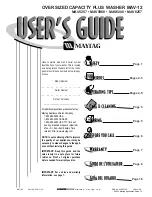
End of the programme
When the programme is complete, the Auto Off function
switches the appliance off automatically.
All buttons are inactive except for the on/off button.
Hints and tips
General
Follow the hints below to ensure optimal cleaning and
drying results in daily use and to protect the
environment.
• Washing dishes in the dishwasher as instructed in
the user manual usually consumes less water and
energy than washing dishes by hand.
• Load the dishwasher to its full capacity to save
water and energy. For best cleaning results, arrange
items in the baskets as instructed in the user
manual and do not overload the baskets.
• Do not pre-rinse dishes by hand. It increases the
water and energy consumption. When needed,
select a programme with a prewash phase.
• Remove larger residues of food from the dishes and
empty cups and glasses before putting them inside
the appliance.
• Soak or slightly scour cookware with firmly cooked-
on or baked-on food before washing it in the
appliance.
• Make sure that items in the baskets do not touch or
cover each other. Only then can the water
completely reach and wash the dishes.
• You can use dishwasher detergent, rinse aid and
salt separately or you can use the multi-tablets (e.g.
''All in 1''). Follow the instructions on the packaging.
• Select a programme according to the type of load
and the degree of soil. ECO offers the most efficient
use of water and energy consumption.
• To prevent limescale buildup inside the appliance:
– Refill the salt container whenever necessary.
– Use the recommended dosage of the detergent
and rinse aid.
– Make sure that the current level of the water
softener agrees with the hardness of the water
supply.
– Follow the instructions in the chapter "Care
and cleaning".
Using salt, rinse aid and detergent
• Only use salt, rinse aid and detergent designed for
dishwasher. Other products can cause damage to
the appliance.
• In areas with hard and very hard water, we
recommend to use basic dishwasher detergent
(powder, gel, tablets containing no additional
agents), rinse aid and salt separately for optimal
cleaning and drying results.
• Detergent tablets do not fully dissolve with short
programmes. To prevent detergent residues on the
tableware, we recommend that you use tablets with
long programmes.
• Always use the correct quantity of detergent.
Insufficient dosage of detergent can result in poor
cleaning results and hard-water filming or spotting
on the items. Using too much detergent with soft or
softened water results in detergent residues on the
dishes. Adjust the amount of detergent based on the
water hardness. Refer to the instructions on the
detergent packaging.
• Always use the correct quantity of rinse aid.
Insufficient dosage of rinse aid decreases the drying
results. Using too much rinse aid results in bluish
layers on the items.
• Make sure that the water softener level is correct. If
the level is too high, the increased quantity of salt in
the water might result in rust on cutlery.
What to do if you want to stop using multi-tablets
Before you start using separately detergent, salt and
rinse aid, complete the following steps:
1. Set the highest level of the water softener.
2. Make sure that the salt and rinse aid containers are
full.
3. Start the 30min programme. Do not add detergent
and do not put dishes in the baskets.
4. When the programme is completed, adjust the
water softener according to the water hardness in
your area.
5. Adjust the released quantity of rinse aid.
Before starting a programme
Before you start the selected programme, make sure
that:
• The filters are clean and correctly installed.
• The cap of the salt container is tight.
• The spray arms are not clogged.
• There is enough salt and rinse aid (unless you use
multi-tablets).
• The arrangement of the items in the baskets is
correct.
• The programme is suitable to the type of load and
the degree of soil.
36
Summary of Contents for KDV10031FA
Page 1: ...KDV10031FA Gebruik saanwijzing Afwasauto maat User Manual Dishwasher...
Page 45: ......
Page 46: ......
Page 47: ......













































